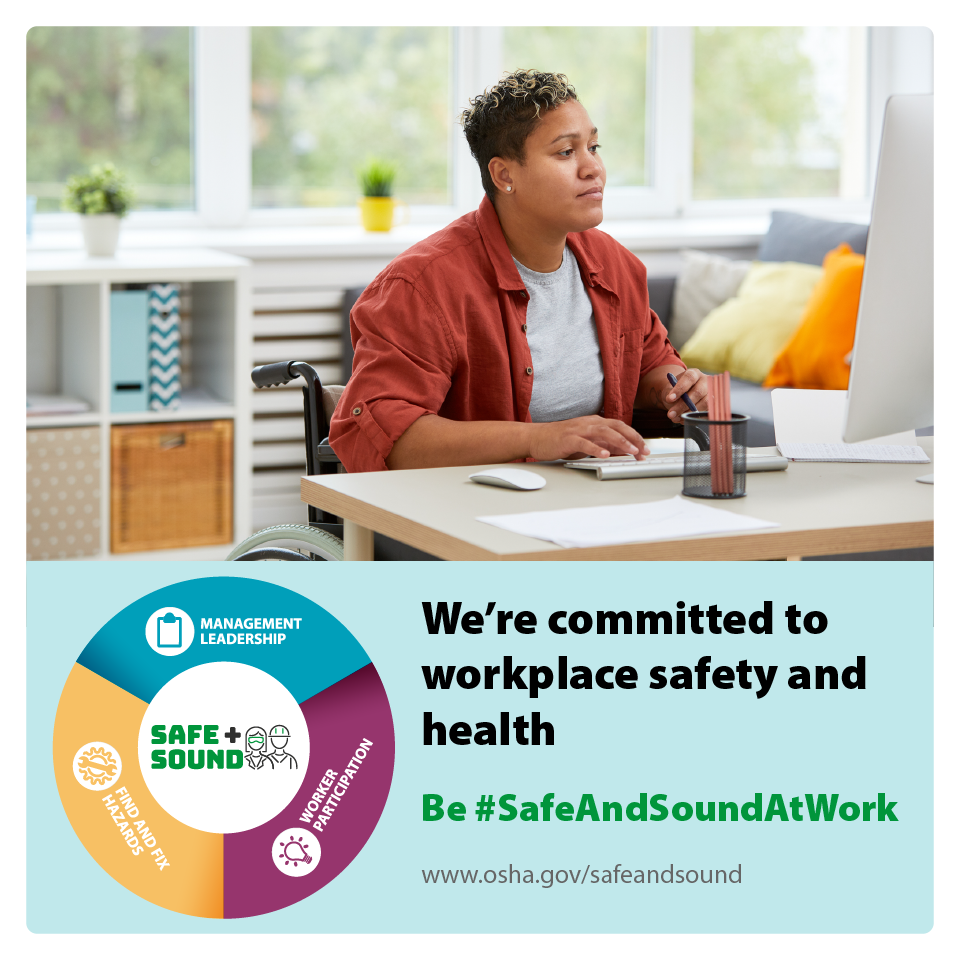This year, OSHA’s Safe and Sound Week promoting safety at work runs from August 9th to the 15th. It’s a great time to recognize the health and safety success of American companies.
And to provide suggestions and information on how any workplace, whether it’s an office, warehouse, or even home environment, can be made safe for its employees. (You can find more details on OSHA’s program by clicking here.)
What are the three main elements of a good program that results in employees being safe and sound at work?
The specific tactics and strategies to implement depend on the industry that you’re in, of course. No need for Material Safety Data Sheets (MSDS) if you only work with computers! If you don’t use fork trucks, there’s no reason to train on forklift safety.
No matter what your company does, there are three components to a solid safety program.
1. Management leadership
Safety comes from the top. If management doesn’t encourage or promote a culture of safety, implementing and maintaining a safety program will be impossible. It’s not just about the talk either; management needs to walk the walk.
That means including safety metrics in KPIs and tying management salaries and rewards including bonuses to these metrics. Only by including safety metrics visibly in performance plans will safety be a top priority. As you know, what doesn’t get tracked doesn’t get improved.
You’ll spend time and money up front to apply a safety program if the one you have currently is nonexistent or ineffective. In the long run, of course, reducing OSHA recordables and worker’s comp claims saves the company money.
Management must be willing to provide the resources necessary to make a safety program happen. For example, if the rule is that objects over 50 pounds require a team lift or a mechanical lift, there must be enough staff to make it happen. Or the mechanical lift must be easily available.
And of course, management must lead by example. If helmets and steel-toed shoes are required of workers, their supervisors and managers must obey the same code.
2. Employee participation
Part of having an effective safety program is having workers that buy into the program. If management is all talk, and there are no safety metrics on performance goals, workers are incentivized to take shortcuts that could end up with injuries.
If the only other human worker in the warehouse is on break, they may try to lift the 60-pound object themselves. If the mechanical lift requires a supervisor’s authorization and they can’t raise one on the radio, they’re going to skip using the lift.
Just as with other business initiatives, workers respond better when they own the program. That means management regularly needs to solicit their opinions on how to make their jobs safer, whether they need additional training or equipment, and feedback on what’s working and what’s not.
Top-down management only goes so far. When employees own the safety program, they’re more likely to stay safe.
3. Finding and fixing hazards
Once everyone is onboard, it’s important to look for potential hazards. Obviously an excellent place to start is with the recordables/WC data that the company has collected over the years. What are the common issues, and are there common areas in the physical space where workers tend to get hurt?
Even in the office there are potential hazards. Leaving trash cans out in the aisle, or running cords to the far-away outlet are common trip hazards. Another big issue for office workers is ergonomics – are they in the proper position whether sitting or standing? Do they have the opportunity to stand at their desks?
Where can you find information on putting together an effective program?
This may be the easiest part of putting together a safety program! OSHA is naturally the best place to start, and has a wealth of free resources. Your state occupational health and safety department can also be very helpful. We’re located in California, and Cal/OSHA has plenty of free information. If your state isn’t that great when it comes to worksite safety, try Cal/OSHA too.
In addition, most of the large industry associations have health and safety resources specific to the industry. Many of them are supporters of OSHA’s Safe and Sound week, so try out your trade organization for tips as well.
What’s the first thing you’re going to do to be safe at work today?
Maybe your company already has a safety culture. You can start safely just by donning your PPE.
But maybe it doesn’t, and you’d like to implement one. Financials are a good place to start: find out how much money the company loses due to workers out on sick leave, worker’s compensation claims, OSHA fines (if applicable), and so forth. Managers often respond to financial incentives so adding up all these expenses can be an eye-opener.
Or maybe you spot a hazard at your workplace, so you’ll fix it. Tape down loose cords running across the floor, remove items from the floor and put them back in the supply closet, or find a box that you can use as a footrest at your desk so your sitting position is ergonomic.
Have a great week being safe and sound!
If you need to work or play standing up at a folding table, make it ergonomic by lifting the surface up with a set of folding table risers. Click here to view our product line.
Lift Your TableⓇ… SAVE YOUR BACK!




